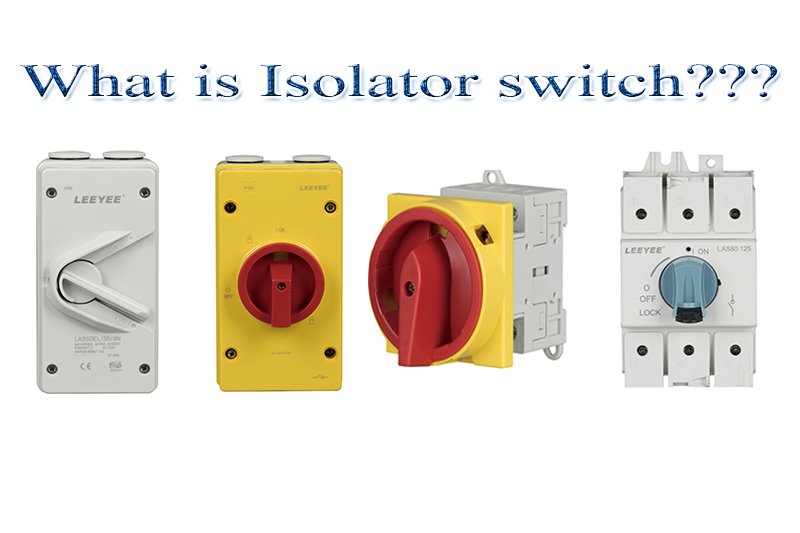In electrical systems, safety is paramount. A malfunctioning isolator switch can lead to dangerous situations, such as electrical fires or equipment damage. These issues can result in costly repairs and potential harm to personnel. LEEYEE is a professional supplier in the electrical industry, specifically providing high-quality isolator switches that meet rigorous safety standards, ensuring reliable operation in diverse applications.
An isolator switch is a crucial device that disconnects electrical circuits to ensure safety during maintenance or emergencies. It provides a visible isolation point, preventing accidental energization of circuits.
Let’s explore the functions, types, and applications of isolator switches and understand why they are essential for safe electrical operations.
Understanding Isolator Switches
An isolator switch, often referred to as a disconnector, is a switch used to isolate a part of an electrical circuit. Its primary function is to ensure that electrical equipment can be safely maintained or repaired without the risk of electric shock or equipment damage.
How Isolator Switches Work
- Basic Operation: Isolator switches operate by physically disconnecting the circuit. When the switch is in the “off” position, it creates a gap in the circuit, ensuring no electrical current can flow.
- Visible Isolation: Many isolator switches feature a mechanism that allows users to see whether the circuit is open or closed, providing a clear indication of whether maintenance can safely proceed.
- Manual Operation: Typically, isolator switches are operated manually, making them straightforward to use. Some advanced models may allow for remote operation.
Types of Isolator Switches
- Single Pole Isolator: Used for single-phase circuits, this type disconnects one conductor, making it suitable for residential applications.
- Double Pole Isolator: Designed for two-phase circuits, often used in domestic appliances that require isolation of both live and neutral wires.
- Three-Pole Isolator: Used in three-phase systems, this type disconnects all three phases, commonly found in industrial applications.
- Multi-Pole Isolators: These can disconnect multiple circuits simultaneously, ideal for complex electrical systems requiring coordinated isolation.
Applications of Isolator Switches
- Industrial Settings: Isolator switches are widely used in industrial environments to ensure the safe maintenance of heavy machinery.
- Renewable Energy: In solar power systems, isolator switches are used to disconnect solar panels for maintenance.
- Residential Use: Home electrical systems utilize isolator switches to safely disconnect circuits for appliances or lighting.
Importance of Using Isolator Switches
- Safety: Isolator switches provide a critical safety feature by ensuring that circuits can be safely de-energized during maintenance. This reduces the risk of electric shock and accidents.
- Equipment Protection: By isolating circuits, these switches help prevent damage to equipment during maintenance or fault conditions.
- Compliance with Regulations: Many electrical codes and standards require the installation of isolator switches in specific applications, ensuring compliance and safety.
Best Practices for Isolator Switch Usage
- Regular Testing: Periodically test isolator switches to ensure they function correctly. Regular maintenance can prevent failures during critical times.
- Proper Installation: Ensure that isolator switches are installed according to manufacturer specifications and local electrical codes.
- Training Personnel: Ensure that all personnel are trained in the proper use of isolator switches to maximize safety and efficiency.
Conclusion
Understanding the role of isolator switches in electrical systems is essential for maintaining safety and compliance. By choosing the right isolator switch and following best practices, you can enhance the safety and reliability of your electrical installations.
Investing in high-quality isolator switches from trusted suppliers like LEEYEE ensures that your electrical systems operate safely and effectively. Take action today to protect your equipment and personnel.
FAQs about Isolator Switches
- What is an isolator switch?
An isolator switch is a device that disconnects electrical circuits for safe maintenance or repair. - How does an isolator switch work?
It physically disconnects the circuit, preventing electrical current from flowing when in the “off” position. - What types of isolator switches are available?
Types include single pole, double pole, three pole, and multi-pole isolators, each suited for different applications. - Where are isolator switches commonly used?
They are used in industrial settings, renewable energy systems, and residential electrical systems for safe circuit disconnection. - How often should isolator switches be tested?
Regular testing is recommended to ensure proper functionality and safety. - Are isolator switches required by electrical codes?
Yes, many codes require isolator switches in specific applications to ensure safety and compliance.
Disclaimer
For professional electrical services and installations, always consult a qualified electrician to ensure compliance with local codes and safety standards.


